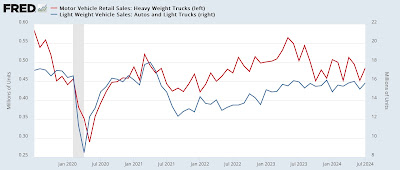Motor vehicle sales and recession: current status
– by New Deal democrat
In the paradigm popularized by Prof. Edward Leamer 20 years ago, motor vehicle sales are the 2nd domino to fall, after housing, in the procession of sectors that turn down prior to recessions.
I haven’t updated this in a while, so let’s take a look.
As an initial matter, the cycle in this sector was particularly hard hit by supply chain kinks during the pandemic, as electronic parts in particular were not produced at nearly a fast enough rate to allow full-scale production. This was a major reason why the prices of motor vehicles rose 20% since just before the pandemic by 2023:
Turning to history, I’ve noted many times before that sales of heavy trucks (red, left scale) tend to turn down first, and much less noisily, than passenger vehicle sales (blue, right scale) before recessions:
In general, sales of heavy weight vehicle must turn down at least -10% on a consistent basis to be consistent with an oncoming recession. The below graph captures the essence of this by measuring the YoY% change in both passenger and heavy truck sales, averaged quarterly to reduce noise, and adding 10% so that the dividing point shows at the zero line:
Sometimes both light vehicle and truck sales are down -10% before recessions, and sometimes heavy truck sales are down much more while passenger vehicle sales are treading water.
For our present situation, here is the post-pandemic close up on absolute numbers:
Truck sales did decline over -10% last year, coincident to the bankruptcy of a major hauler, Yellow Truck. Passenger vehicle sales are still holding steady.
Now here is the YoY% look, monthly, again adding 10% so that the crucial cutoff appears at the zero line:
Heavy truck sales have flirted with the -10% level for the last 10 months. If they remain at their current level for several more months, the YoY comparison will be unchanged. Passenger vehicle sale remain steady.
The bottom line is that motor vehicle sales have not given, and are not now giving, any recession signal.
The Bonddad Blog
Manufacturing treads water in April, while real construction spending turned down in March (UPDATE: and heavy truck sales weren’t so great either), Angry Bear by New Deal democrat






i have heard and read a lot about EV sales slowdown, but if you look at the ICE market you see it even worse as there it appears more like a complete stall of the ICE market, in the self-styled capital of trucks (Texas) you see lots of dealers lots that have trouble with way too many trucks and SUV for their lots, all new ones and have had to store inventory on used lots, or add additional space else where. Some ICE vehicles have been compared (price wise) with like vehicles (most popular seems to be comparing a regular cab truck to a super crew truck (basically comparing 2 door trucks with 4 door trucks) and 2wd trucks with 4wd trucks. and the ‘surprise’ that the EV is more, seems disingenuous at best
dw:
To see an end to the numbers of pickup and humungous suburban’s, etc. on the roads would do much to increasing energy savings and the decreasing damage to roads. In additions to the numbers of them involved in accidents by aggressive driving. Sixty percent of the vehicles on the road IN az are of these type. They are under taxed. I would like to see the state issue license plates according to the size and weight of the vehicle and what they can carry. It would help in road repair.